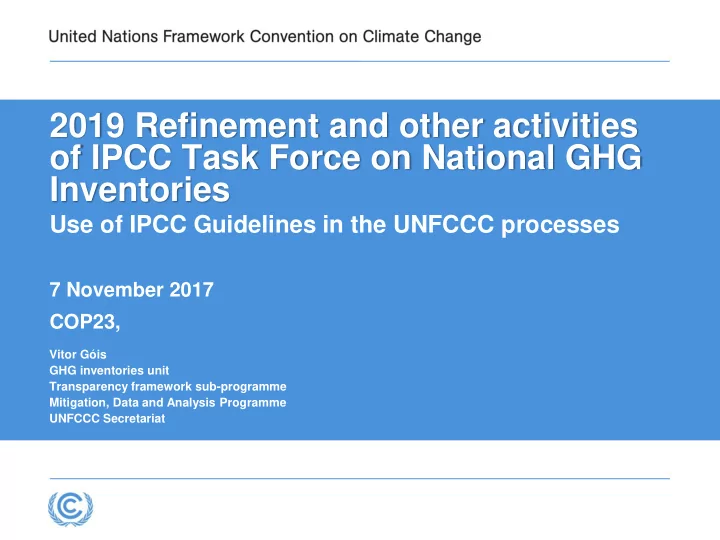

2019 Refinement and other activities of IPCC Task Force on National GHG Inventories Use of IPCC Guidelines in the UNFCCC processes 7 November 2017 COP23, Vitor Góis GHG inventories unit Transparency framework sub-programme Mitigation, Data and Analysis Programme UNFCCC Secretariat
Outline • History and background • Where are we now? • Annex I Parties • Transition to the 2006 IPCC Guidelines and related issues • Non-Annex Parties • Paris Agreement
History and background 2020 COP25 CMP15 COP24 CMP14 COP23 CMP13 Paris Agreement COP22 CMP12 Paris Agreement COP21 CMP11 5,7&8 (Rep., accounting & review) COP20 Revised UNFCCC review Guidelines CMP10 Revised UNFCCC reporting Guidelines COP19 CMP9 2013 KP Supplement 2013 Wetlands COP18 CMP8 LULUCF, Met., common metrics COP17 BR (Annex I) + BUR (non Annex I) CMP7 COP16 CMP6 2010 COP15 CMP5 COP14 CMP4 COP13 CMP3 COP12 CMP2 Marrakesh (Rep., accounting & review) 2006 IPCC Guidelines COP11 CMP1 COP10 COP9 Guidelines GHG Inventories Annex I Good Practice Guidance for LULUCF COP8 Guidelines NC non Annex I COP7 Good Practice Guidance COP6 2000 COP5 Guidelines GHG Inventories Annex I COP4 COP3 KP - Arts. 5,7&8 COP2 Revised 1996 GL Rev. Guidelines NC (Annex I + non AnnexI) COP1 Guidelines National Communications UNFCCC - Arts. 4.a & 12.1a
Annex I – UNFCCC reporting and review guidelines • New UNFCCC Annex I inventory reporting guidelines (decision 24/CP.19) : Update of previous guidelines to incorporate methodological revisions/updates in the 2006 • IPCC Guidelines for National Greenhouse Gas Inventories (from 2015 submissions onwards) Annex I Parties “shall” use the methodologies in the 2006 IPCC Guidelines, unless stated • otherwise in the UNFCCC reporting guidelines, and any supplementary methodologies agreed by the COP However, major difference: estimates of emissions and removals are reported separately • for the Agriculture and LULUCF sectors (not AFOLU!) Use of the 2013 Supplement to the 2006 IPCC Guidelines for National • Greenhouse Gas Inventories: Wetlands (“encouragement”; required reporting of rewetting and drainage) (SBSTA) Annex I Parties could use EFs or parameters provided in the IPCC Emission Factor Database • if lack country-specific information demonstrate that those are appropriate in specific • national circumstances and are more accurate than default data provided in the 2006 IPCC Guidelines
Annex I – Kyoto Protocol reporting/review guidelines • Methodologies for CP2 (decision 4/CMP.7) • “Shall” be consistent with the 2006 IPCC Guidelines as implemented through the revised UNFCCC Annex I reporting guidelines • National systems (decision 19/CMP.1 + 3/CMP.11) • KP-LULUCF (decisions 2/CMP.7 and 6/CMP.9) “Shall” apply , as appropriate, the 2013 Revised Supplementary Methods and • Good Practice Guidance arising from the Kyoto Protocol in consistency with 2/CMP.7 “Shall” apply the 2013 Supplement to the 2006 IPCC Guidelines: (Wetlands • Supplement) for providing information on wetland drainage and rewetting elected KP-LULUCF activity Parties are encouraged to use the Wetlands Supplement for any other KP- • LULUCF activities
Annex I – transition to the new UNFCCC guidelines • Training available (GHG inventories): Available • New training modules available since 2015 • Generally, not many issues related to the use of previous IPCC • Guidelines Parties have had the opportunity to get to know the 2006 IPCC Guidelines for a • number of years However, Parties had to continue reporting in accordance to previous UNFCCC • guidelines up to 2015 Parties needed some time to update their data collection and tracking systems and • infrastructure to ensure smooth transition to 2006 guidelines Use of new guidelines may had some impacts on commitments and • targets in limited cases: The 2006 IPCC Guidelines resulted in some quantitative recalculations for national • inventories: updated EFs and parameters, new subcategories introduced and methodologies now available for some categories which were previously not available
Non annex I – use of the IPCC guidelines • Reporting guidelines for National Communications of non-Annex I Parties (decision 17/CP.8): • Revised 1996 IPCC Guidelines (“ should” be used) • IPCC good practice guidance (“encouraged”) • UNFCCC biennial update reporting guidelines for Parties not included in Annex I to the Convention (decision 2/CP.17, Annex III) • Updates of sections on the GHG inventories based on the best information available using • Revised 1996 IPCC Guidelines • Good Practice Guidance and • IPCC good practice guidance for LULUCF
Non annex I – reporting/review guidelines • Use of the 2006 IPCC Guidelines • June 2017 • 34 BURs assessed
Paris Agreement • Framework for transparency (Art. 13 of the Paris Agreement): • E ach Party “shall” regularly provide an national inventory report using good practice methodologies accepted by the IPCC and agreed upon by the Conference of the Parties serving as the meeting of the Parties to the Paris Agreement (CMA) Accounting for National Determined Contributions (Art. 4.13 of the Paris • Agreement): Parties account for GHG emissions and removals in accordance with • methodologies and common metrics assessed by the IPCC and adopted by the CMA (decision 1/CP.21) Possible outcomes: • Submissions under APA agenda items 3c and 5 • e.g. 2006 GLs/latest IPCC GLs or 1996 GLs + GPG •
Thank you
Recommend
More recommend